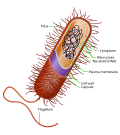 | A prokaryote (/proʊˈkærioʊt, -ət/, also spelled procaryote) is a single-cell organism whose cell lacks a nucleus and other membrane-bound organelles. The... 44 KB (4,769 words) - 23:36, 12 April 2024 |
 | They constitute a major group of life forms alongside the two groups of prokaryotes: the Bacteria and the Archaea. Eukaryotes represent a small minority... 61 KB (6,029 words) - 18:37, 23 April 2024 |
 | Nutrition (section Prokaryote) unavailable. Prokaryotes, including bacteria and archaea, vary greatly in how they obtain nutrients across nutritional groups. Prokaryotes can only transport... 36 KB (4,008 words) - 21:17, 28 April 2024 |
 | Prokaryotic cytoskeleton (redirect from Prokaryote cytoskeleton) cytoskeleton is the collective name for all structural filaments in prokaryotes. It was once thought that prokaryotic cells did not possess cytoskeletons... 25 KB (3,048 words) - 17:03, 6 April 2024 |
 | the dinoflagellate protists. He first coined the terms "eukaryote" and "prokaryote" in a 1925 paper, but did not elaborate on the concept; Roger Stanier... 4 KB (305 words) - 14:05, 8 December 2023 |
The International Code of Nomenclature of Prokaryotes (ICNP) or Prokaryotic Code, formerly the International Code of Nomenclature of Bacteria (ICNB) or... 11 KB (1,296 words) - 17:21, 13 January 2024 |
 | Circular chromosome (redirect from Circular prokaryote chromosome) of circular DNA, unlike the linear chromosome of most eukaryotes. Most prokaryote chromosomes contain a circular DNA molecule – there are no free ends to... 21 KB (2,794 words) - 20:32, 9 February 2024 |
 | prokaryotic cells, which lack a nucleus but have a nucleoid region. Prokaryotes are single-celled organisms such as bacteria, whereas eukaryotes can... 62 KB (6,360 words) - 07:29, 17 April 2024 |
 | Phototroph (redirect from Phototrophic prokaryotes) Phototrophs (from Ancient Greek φῶς, φωτός (phôs, phōtós) 'light', and τροφή (trophḗ) 'nourishment') are organisms that carry out photon capture to produce... 8 KB (737 words) - 01:11, 6 August 2023 |
 | Extremophile (redirect from Extremophilic prokaryotes) An extremophile (from Latin extremus 'extreme', and Ancient Greek φιλία (philía) 'love') is an organism that is able to live (or in some cases thrive)... 62 KB (6,574 words) - 16:52, 19 April 2024 |
 | Chromosome (section Prokaryotes) origins. The genes in prokaryotes are often organized in operons, and do not usually contain introns, unlike eukaryotes. Prokaryotes do not possess nuclei... 65 KB (6,602 words) - 10:25, 29 April 2024 |
 | Ribosomal RNA (section In prokaryotes) 60% rRNA and 40% ribosomal proteins, though this ratio differs between prokaryotes and eukaryotes. Although the primary structure of rRNA sequences can... 60 KB (7,195 words) - 20:52, 29 March 2024 |
 | Unicellular organism (section Prokaryotes) general categories: prokaryotic organisms and eukaryotic organisms. Most prokaryotes are unicellular and are classified into bacteria and archaea. Many eukaryotes... 33 KB (3,362 words) - 19:19, 25 April 2024 |
 | antibiotics. A possible transitional form of microorganism between a prokaryote and a eukaryote was discovered in 2012 by Japanese scientists. Parakaryon... 73 KB (7,720 words) - 14:19, 4 March 2024 |
 | divided into several different kingdoms. Originally his split of the prokaryotes was into Eubacteria (now Bacteria) and Archaebacteria (now Archaea).... 15 KB (1,602 words) - 00:49, 22 March 2024 |
 | only from a single specimen, described in 2012. It has features of both prokaryotes and eukaryotes but is apparently distinct from either group, making it... 10 KB (928 words) - 08:46, 18 April 2024 |
on protists, and Ruggiero et al., 2015, covering both eukaryotes and prokaryotes to the rank of Order, although both exclude fossil representatives. A... 69 KB (6,804 words) - 03:00, 15 April 2024 |
 | Untranslated region (section Prokaryotes) initiate translation. The mechanism of translation initiation differs in prokaryotes and eukaryotes. The 3' UTR is found immediately following the translation... 12 KB (1,454 words) - 21:01, 18 January 2024 |
Fission (biology) (section Fission of prokaryotes) Binary fission in a prokaryote... 19 KB (2,203 words) - 14:23, 20 April 2024 |
 | Bacterial transcription (redirect from Transcription in prokaryotes) Bacterial transcription is the process in which a segment of bacterial DNA is copied into a newly synthesized strand of messenger RNA (mRNA) with use of... 21 KB (2,370 words) - 11:41, 10 December 2023 |
 | Pan-genome (section Prokaryote pangenome) elements that are shaped by selection and drift. Some studies point that prokaryotes pangenomes are the result of adaptive, not neutral evolution that confer... 50 KB (5,348 words) - 02:51, 8 April 2024 |
Cell physiology (section Prokaryotes) structure.[page needed] There are two types of cells: prokaryotes and eukaryotes. Prokaryotes were the first of the two to develop and do not have a... 8 KB (857 words) - 22:10, 21 November 2023 |
 | asexually, as in single-celled organisms such as bacteria and other prokaryotes, and parthenogenetic or apomictic multi-celled organisms. DNA barcoding... 102 KB (10,485 words) - 13:19, 26 April 2024 |
 | "solitary") is historically a biological kingdom that is made up of prokaryotes. As such, it is composed of single-celled organisms that lack a nucleus... 22 KB (2,879 words) - 23:47, 11 April 2024 |
Enzyme Eukaryote Fermentation Metabolism Meiosis Mitosis Photosynthesis Prokaryote Genetics DNA Epigenetics Evolutionary developmental biology Gene expression... 80 KB (9,670 words) - 12:52, 29 April 2024 |
 | prokaryotes. The set of chromosomes in a cell is collectively known as its genome. In eukaryotes, DNA is mainly in the cell nucleus. In prokaryotes,... 132 KB (13,782 words) - 20:16, 28 April 2024 |


